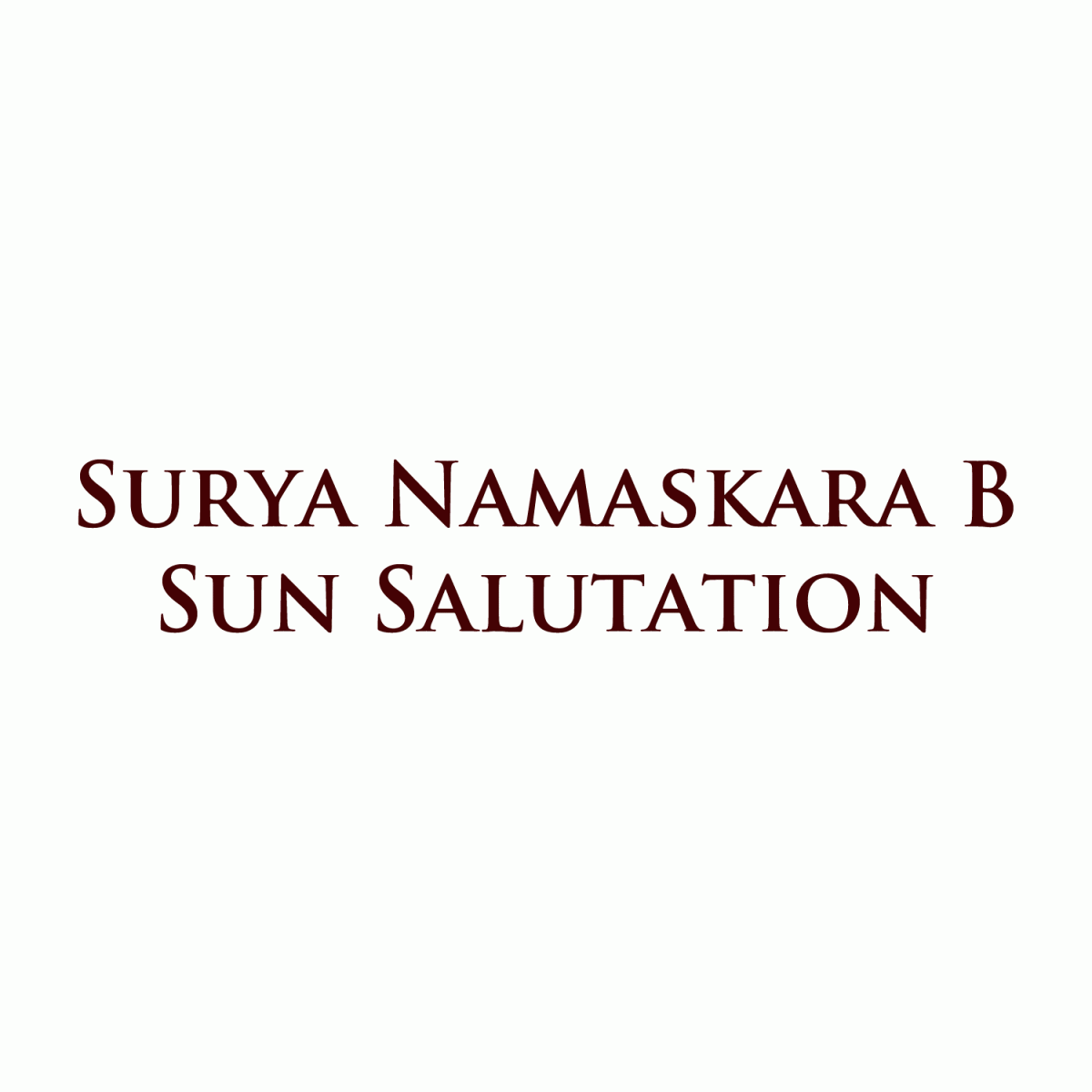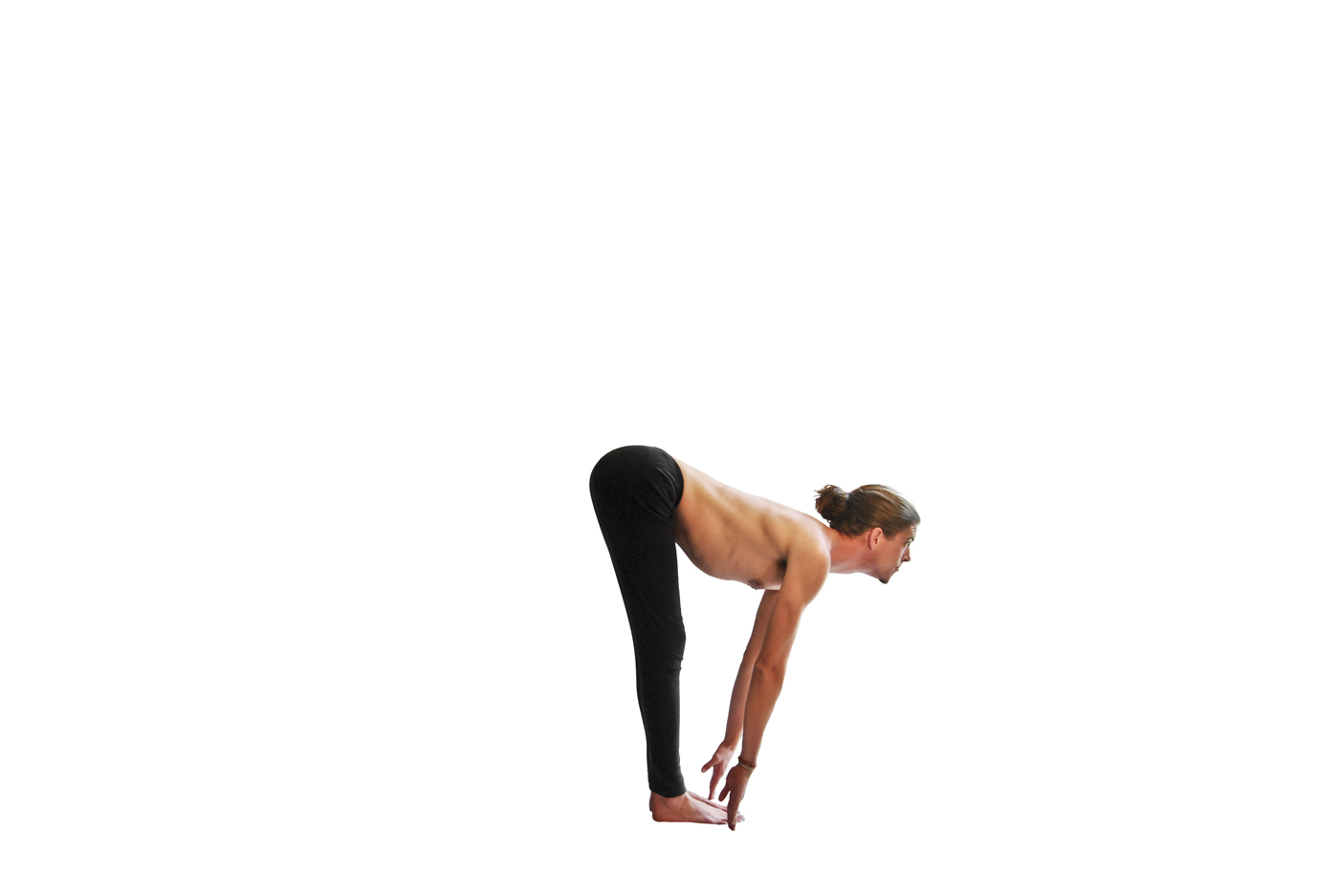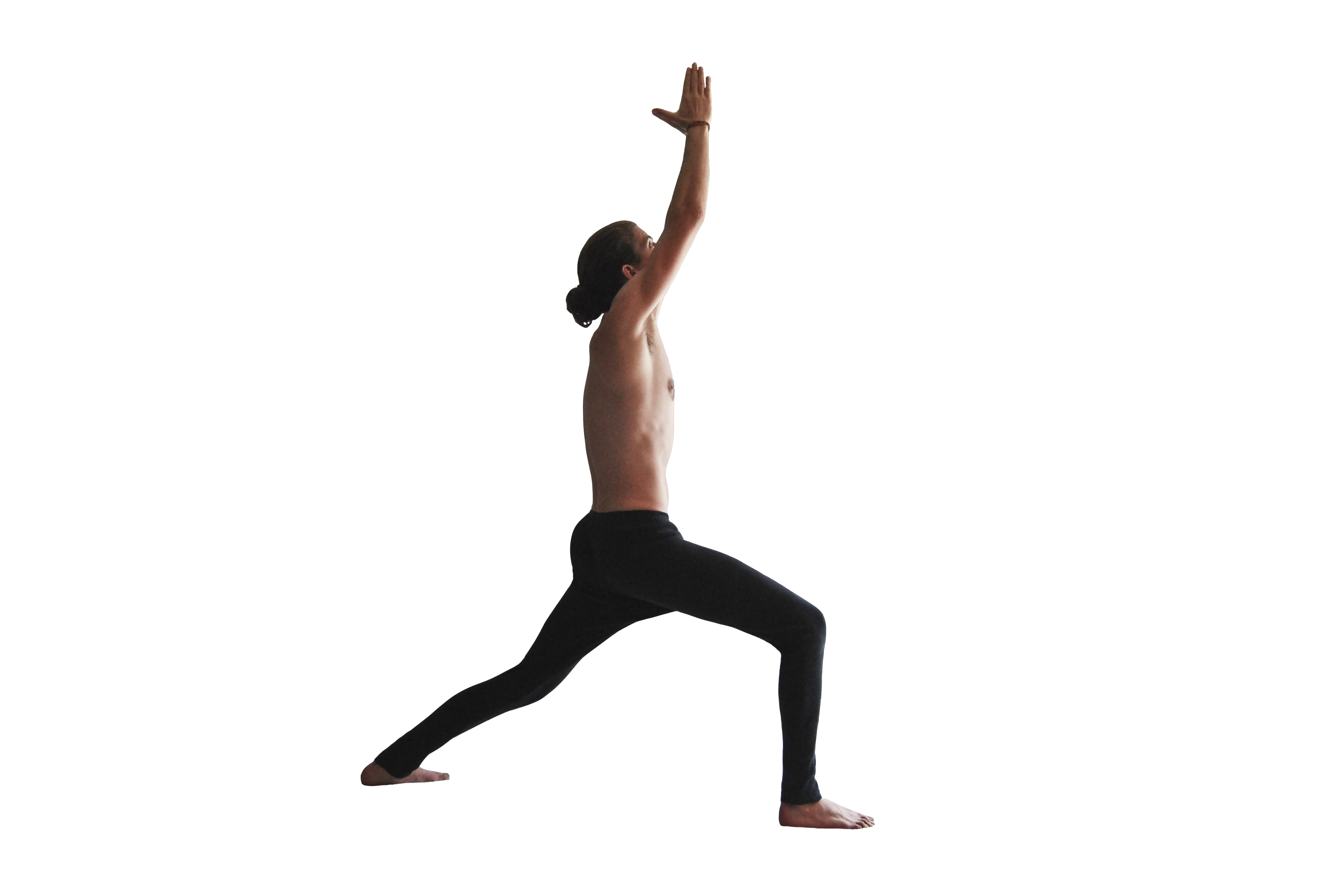Sun Salutation: Surya Namaskara B
Note: Touch or hover your mouse over underlined terms for a definition.
Performance of Surya Namaskara B follows Surya Namaskara A. It is typically performed five times, but this may vary depending on the practitioner and the temperature: practice it as necessary until you begin to perspire lightly.
Surya Namaskara B consists of seventeen vinyasas.
Click for full size (5000px):
Some of these postures have already been addressed in Surya Namaskara A. Read the discussion of alignment there before beginning this article.
*Disambiguation of anatomical terms:
- Posterior rotation of the hips results in a lengthening of the lumbar spine and quadriceps.
- Extension of the spine (lordosis) is arching backwards in one or more of the four sections of the spine.
- Eccentric contraction is a movement in which a muscle is lengthening while under tension, for example, lowering the body slowly from a pull-up position.
This is a brief cueing of the Sun Salutation for your reference in practice, followed by full descriptions of each vinyasa.
0. Samasthiti : Stand upright, and the body aligning on a central vertical axis.
1. Inhale, reach up overhead stretching the whole body.
2. Exhale, fold forward and press the palms down.
3. Inhale, look forward and lengthen the front of the body, reaching through the crown of the head.
4. Exhale, plant the palms and hop back to chaturanga.
5. Inhale, pull the heart forward through the arms and fan the ribs open. Drag the feet along the mat and lengthen the lower back.
6. Exhale, roll over the toes and lift the hips up and back to downward facing dog. Lift with the strength of the legs to pull the spine taut and long. Still exhaling, step your right foot forward between your hands. Turn your left foot to a 45 degree angle.
7. Inhale, Keeping the right knee bent and the left heel down, raise your hands until they meet overhead. Look at your thumbs.
8. Exhale, Step back and lower down slowly, hovering just above the mat with the shoulders wide
9. Inhale, Pull the heart forward through the arms, gaze upwards.
10. Exhale, roll over the toes and lift the hips up and back to downward facing dog. Lift with the strength of the legs to pull the spine taut and long. Still exhaling, step your left foot forward between your hands. Turn your right foot to a 45 degree angle.
11. Inhale, Keeping the left knee bent and the right heel down, raise your hands until they meet overhead. Look at your thumbs. Lift from the low belly, lengthen the spine.
12. Exhale, Step back and lower to chaturanga, the shoulder blades wide and the back of the heart open.
13. Inhale, Pull forward onto the tops of the feet, keeping the legs lifted and the waistline long.
14. Exhale, Lift up and back to downward facing dog. Make the entire sheath of the legs very active, as if trying to pull all the weight out of the hands.
15. Crouch, look forward and hop both feet forward. Inhale, look forward and lengthen.
16. Exhale, fold fully and press the palms down.
17. Inhale, bending the knees deeply, join the palms overhead as you gaze to the thumbs.
0. Exhale, Samasthiti.
Or, listen to this audio recording leading you through 5 Surya Namaskara B.
Detailed instruction:
0. Samasthiti – Equilibrium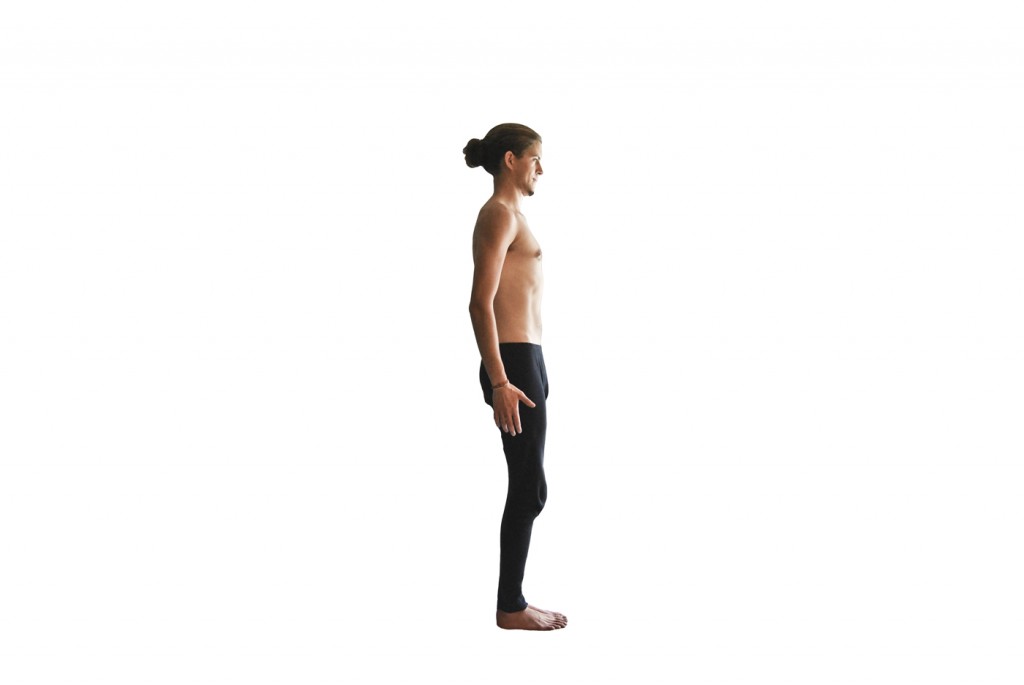
Vinyasa Ekam (One – Utkatasana):
Breath: Inhale
Gaze: Thumbs
Bend the knees, grazing the fingertips along the mat and then press your hands together overhead. Squeeze the knees together, keeping the knees bent deeply as you sink your pelvis down towards the floor. The knees remain above the toes – bringing the knees farther in front can cause pain. Lift your gaze by pulling the crown of the head upwards and raising the chin while maintaining length in the neck (without compressing the cervical spine).
The ideal position is a balance between bending the knees as deeply as possible while maintaining space in the spine. There is a strong tendency in this position to hyperextend the lower back, arching the spine deeply. This is felt as a collapse in the lower back, making it feel compressed or pinched rather than buoyant. Counteract this motion by using the internal muscles of the pelvis to rotate the hips posteriorly* (tighten the hamstrings), lengthening the quadriceps, and press back through the lumbar spine to find a neutral lumbar spine alignment. This augments the internal support of the bandha. If this movement is difficult, lower your arms until they point straight forward so they are parallel with the floor and focus on expanding the breath into the lower back before raising the arms.
Vinyasa Dve (Two):
Breath: Exhale
Gaze: Nose
Keep the palms together, bringing both hands to the sternum as you straighten the legs, folding forward and press the hands down to either side of the feet.
Vinyasa Trini (Three):
Breath: Inhale
Gaze: Upward/Third Eye
Look forward, lifting onto the fingertips as you extend the spine* and look forward.
Vinyasa Chatvari (Four – Chaturanga Dandasana):
Breath: Exhale
Gaze: Nose
Jump back, then lower down to chaturanga, hovering just above the mat.
(Methods discussed in Surya Namaskara A)
Vinyasa Pancha (Five – Urdhva Mukha Svasana):
Breath: Inhale
Gaze: Down the length of the nose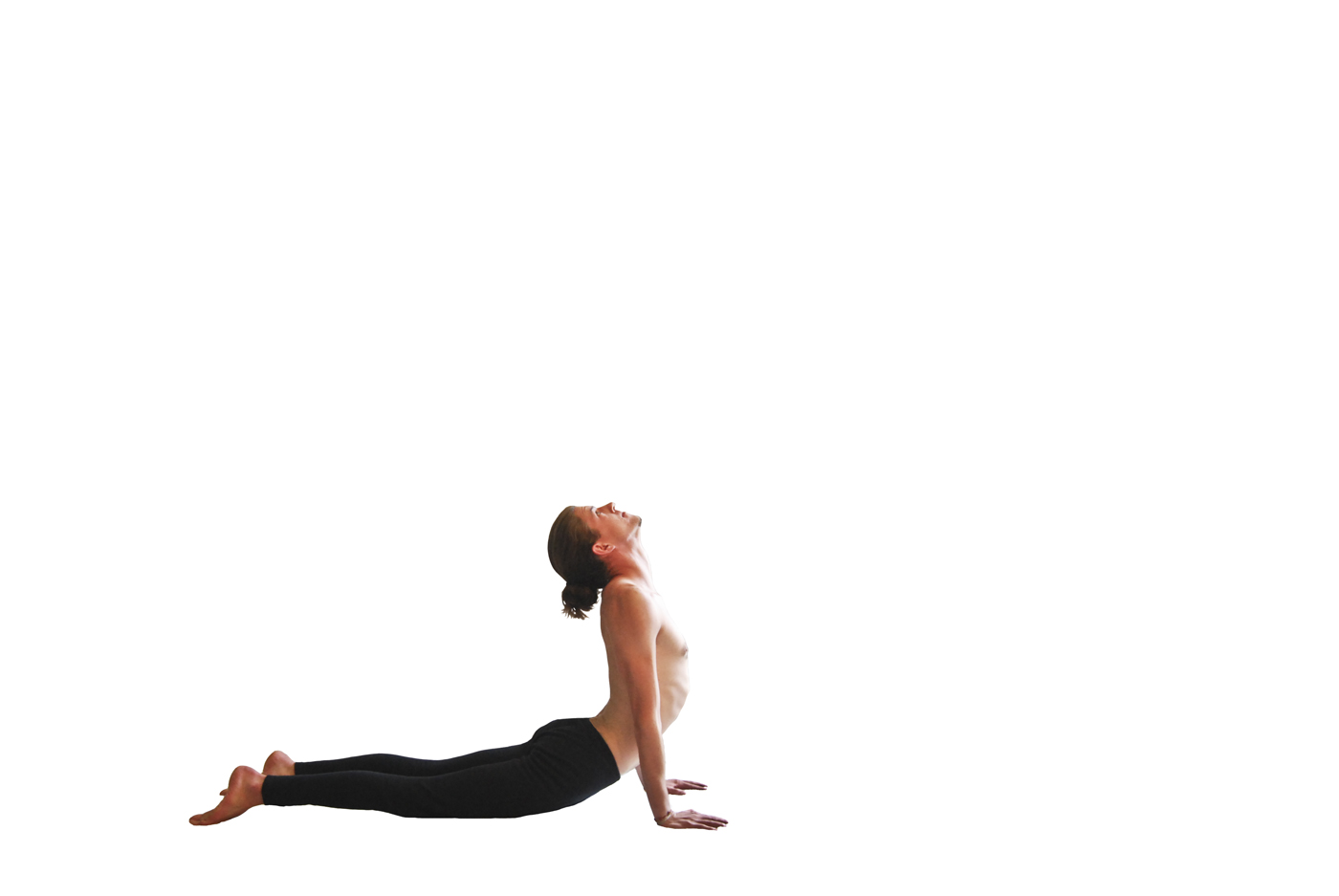
Drag yourself forward, lifting the heart through the arms.
Vinyasa Sat (Six – Adho Mukha Svanasana):
Breath: Exhale
Gaze: Downward (or knees)
Lift the pelvis towards the ceiling, keeping the legs and arms fully engaged.
Vinyasa Sapta (Seven – Virabhadrasana A):
Breath: Inhale
Gaze: Thumbs
Step your right foot forward between the hands so that the knee is directly above the ankle. Rotate the left foot until the toes are pointing to the left at a 45 degree angle. Press into the outside edge of the back foot, engaging the quads to wrap the left hip around towards the right. Lift the front of the hips and the navel upwards, directing breath into the lower back to expand and reduce any hyperextension or collapse in the spine. Bend the right knee deeply, up to 90 degrees. Press the palms together and lift the fingers up, starting from the movement of the shoulder blades.
This position – Warrior I – is among the most beneficial postures in the primary series for stretching and strengthening the psoas muscle, which connects the inside of the lumbar spine to the upper, inside part of the femur, running inside the pelvis. Weakness of this muscle contributes to instability and pain of the lower back. This is a very complex and difficult movement; approach it in distinct phases to ensure the quality of the asana. Working through the following steps may take one inhalation or one year – the length of time is unimportant, take the time necessary to understand fully.
Begin by keeping both feet facing forward (do not turn the left foot out) as you step forward, and keep both legs straight or slightly bent. Lift the torso to a standing position. Square your hips fully, pressing the left hip forward and the right hip back. Use your hands if that helps – proper hip position is essential.
Next, press back through the lumbar spine, rotating the pelvis posteriorly. This movement lengthens the quadriceps and psoas. Even in a standing position, before bending the right knee, this movement will create a very intense sensation, especially through the left side of the pelvis and the upper left thigh. This stretching feeling is the psoas, which is being lengthened from both ends as the lower back and the femur head move away from each other. By keeping the back leg engaged as you press through the heel, the psoas is being contracted eccentrically.*
Fully engage the abdominal muscles to support the lumbar spine and keep it in position as you bend the right knee. Be very mindful here, as a tight psoas will cause hyperextension of the lumbar spine and dissipate most of the benefit of this posture. As you bend the knee, you will reach a point where the body will attempt to hyperextend the spine to deepen the bend in the front knee. Find this point, and stay there; do not allow the upper body position to be compromised for a superficial ‘deepening.’ It’s OK for the heel to lift off the ground – we’ll address that later.
Next, lift the hands overhead without arching backwards. Keep the core strong to prevent the movement of raising the hands from rotating the rib cage into spinal extension.
It is common to observe inexperienced practitioners performing a variation of chandrasana (‘crescent moon pose’), which is a full backbend, rather than Warrior I, in which the upper body is kept in an upright, neutral position; this is due to tightness of the psoas and shoulders; or else twisting the hips halfway between Warrior I and Warrior II. It is essential to practice this position correctly so as not to reinforce patterns of weakness in the core and lower back.
Only when you have mastered the preceding steps should the left foot be turned out. Rotate the foot out slowly, keeping the left hip firmly in position. The final position is experienced when the foot and knee face 45 degrees to the left while the hip faces directly forward. The patella and the toes must be aligned; turning the foot out more than the knee will create a shearing force in the knee joint, creating instability over time.
Correct performance of Virabhadrasana I is characterized by
- Hips squaring forward
- Straight and lifted back knee
- Long spine. Some backbend will remain in the spine, but it should feel taut and supported in a smooth, lengthening arc rather than collapsing, segmented, or heavy.
Note for the extremely flexible: Do not rotate your pelvis posteriorly so much that the lumbar spine reverses its curve completely. For most practitioners, rotating the pelvis as much as possible here will at most result in a neutral position.
Vinyasa Ashtau (Eight – Chaturanga Dandasana):
Breath: Exhale
Gaze: Nose
Lower the hands to the mat, then step the right foot back and lower the body into chaturanga dandasana. Exhale fully. Don’t rush to the next vinyasa.
Vinyasa Nava (Nine – Urdhva Mukha Svasana):
Breath: Inhale
Gaze: Down the length of the nose
Slide forward into Urdhva Mukha Svasana (Upward Facing Dog), pressing down through the tops of the feet and the fingertips.
Vinyasa Dasha (Ten – Adho Mukha Svanasana):
Breath: Exhale
Gaze: Downward (or knees)
Roll over the toes and lift the hips up and back to downward facing dog. Lift with the strength of the legs to pull the spine taut and long.
Vinyasa Eka-Dasha (Eleven – Virabhadrasana A):
Breath: Inhale
Gaze: Thumbs
Step the left foot forward between the hands. Repeat vinyasa seven with the left foot forward.
Vinyasa Dve-Dasha (Twelve – Chaturanga Dandasana):
Breath: Exhale
Gaze: Nose
Lower the hands to the mat, then step the left foot back and lower the body into chaturanga dandasana.
Vinyasa Trayo-Dasha (Thirteen – Urdhva Mukha Svanasana):
Breath: Inhale
Gaze: Down the length of the nose
Slide forward into Urdhva Mukha Svasana (Upward Facing Dog), pressing down through the tops of the feet and the fingertips.
Vinyasa Chatur-Dasha (Fourteen – Adho Mukha Svanasana):
Breath: Exhale
Gaze: Downward (or knees)
Roll over the toes and lift the hips up and back to downward facing dog. Lift with the strength of the legs to pull the spine taut and long.
Vinyasa Pancha-Dasha (Fifteen):
Breath: Inhale
Gaze: Upwards/Third Eye
Crouch, bringing the knees and ribs together. Hop forward.
(Technique discussed in Surya Namaskara A)
Vinyasa So-Dasha (Sixteen):
Breath: Exhale
Gaze: Nose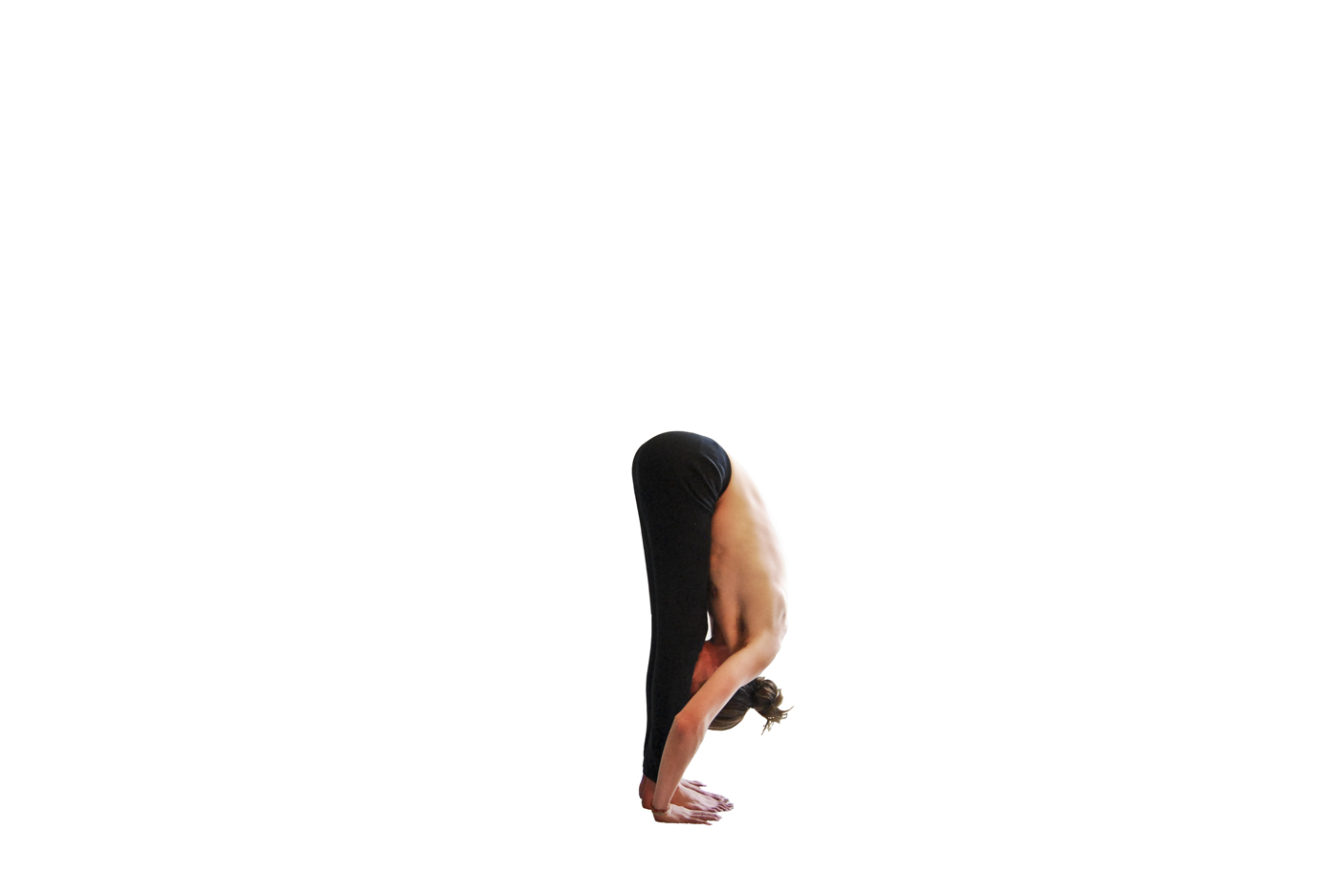
Fold forward fully, pressing the palms to the mat.
Vinyasa Sapt-Dasha (Seventeen – Utkatasana):
Breath: Inhale
Gaze: Thumbs
Bend the knees, then raise the arms in front of the body until they are overhead (or reaching forward as described in vinyasa one variation.)
0. Samasthiti – Equil
Straighten the legs and bring the hands down to the sides.
This is one complete Surya Namaskara B.

